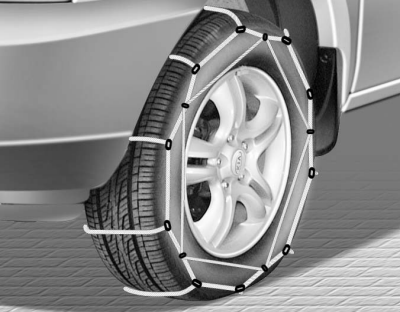Hyundai Tucson: Snow or icy conditions / Tire chains

Since the sidewalls of radial tires are thinner than other types of tires, they may be damaged by mounting some types of tire chains on them.
Therefore, the use of snow tires is recommended instead of tire chains. Do not mount tire chains on vehicles equipped with aluminum wheels; if unavoidable use a wire type chain. If tire chains must be used, use genuine HYUNDAI parts and install the tire chain after reviewing the instructions provided with the tire chains.
Damage to your vehicle caused by improper tire chain use is not covered by your vehicle manufacturerŌĆÖs warranty.
WARNING
The use of tire chains may adversely affect vehicle handling:
- Drive less than 20 mph (30 km/h) or the chain manufacturerŌĆÖs recommended speed limit, whichever is lower.
- Drive carefully and avoid bumps, holes, sharp turns, and other road hazards, which may cause the vehicle to bounce.
- Avoid sharp turns or locked wheel braking.
Ō£Į NOTICE
- Install tire chains on the front tires for 2WD vehicles or on all four tires for AWD vehicles. It should be noted that installing tire chains on the tires will provide a greater driving force, but will not prevent side skids.
- Do not install studded tires without first checking local, state and municipal regulations for possible restrictions against their use.
Chain installation
When installing tire chains, follow the manufacturer's instructions and mount them as tightly possible. Drive slowly (less than 20 mph (30 km/h)) with chains installed. If you hear the chains contacting the body or chassis, stop and tighten them. If they still make contact, slow down until the noise stops. Remove the tire chains as soon as you begin driving on cleared roads.
When mounting snow chains, park the vehicle on level ground away from traffic. Turn on the vehicle Hazard Warning Flasher and place a triangular emergency warning device behind the vehicle (if available).
Always place the vehicle in P (Park), apply the parking brake and turn off the engine before installing snow chains.
CAUTION
When using tire chains:
- Wrong size chains or improperly installed chains can damage your vehicle's brake lines, suspension, body and wheels.
- Use SAE ŌĆ£SŌĆØ class or wire chains.
- If you hear noise caused by chains contacting the body, retighten the chain to prevent contact with the vehicle body.
- To prevent body damage, retighten the chains after driving 0.3~0.6 miles (0.5~1.0 km).
- Do not use tire chains on vehicles equipped with aluminum wheels. If unavoidable, use a wire type chain.
- Use wire chains less than 0.59 inch (15 mm) wide to prevent damage to the chainŌĆÖs connection.
 Snow tires
Snow tires
WARNING
Snow tires should be equivalent in size and type to the vehicle's
standard tires. Otherwise, the safety and handling of your vehicle may be adversely
affected.
If you mount snow tires on ...
 Trailer towing
Trailer towing
If you are considering to tow with your vehicle, you should first check with
your state's Department of Motor Vehicles to determine legal requirements. Since
laws vary from state to state the requ ...
Other information:
Hyundai Tucson (LM) 2010-2015 Owners Manual: Sunroof opening and closing
To open:
Press the sunroof control lever backward to the first detent position.
Release the switch when you want the sunroof to stop.
To close:
Press the sunroof control lever backward to the first detent position.
Release the switch when you want the sunroof to stop.
WARNING
Make sure heads, ...
Hyundai Tucson (LM) 2010-2015 Owners Manual: 105,000 miles (168,000 km) or 84 months
Rotating tires
Inspect air cleaner filter
Inspect vacuum hose
Inspect air conditioning refrigerant
Inspect brake hoses and lines
Inspect drive shafts and boots
Inspect exhaust pipe and muffler
Inspect front brake disc/pads, calipers
Inspect propeller shaft (AWD)
Inspect rear bra ...
